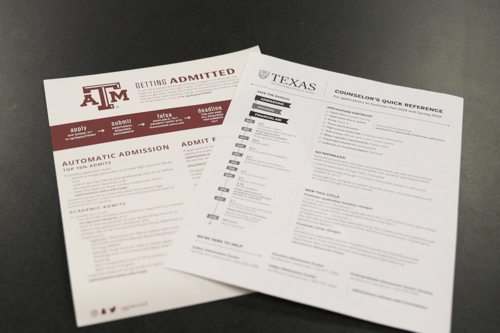Is the Top Ten Percent Law Necessary?

©The Talon News | Faith Stapleton
Two admission instruction sheets for Texas public universities, UT and Texas A&M, represent the colleges that are most effected by the Top Ten Percent Law, at Argyle High School, in Argyle, TX, on September 20, 2018. (Faith Stapleton)
September 21, 2018
Texas legislature voted in Texas House Bill 588, often referred to as the “Top 10% Rule,” in 1997 as law. This law is deemed controversial by many and there have been several attempts to repeal it since, the latest being in 2017, with a new bill to completely eliminate the law by Senator Kel Seliger, R-Amarillo. However, the bill lacked votes and didn’t make it to the Senate floor, but that doesn’t mean that the old law should stay.
Current law states that all students who graduate in the top ten percent of their class are guaranteed automatic admissions to all state-funded universities. The law has caused problems for the larger universities in Texas such as UT and Texas A&M. It is also often criticized for its restrictions on the number of students who can be admitted that are not part of the top ten percent. The Texas House Bill 588 should be revoked, because it limits universities, doesn’t do its initial purpose, and is unfair for students in smaller schools.
This past year, UT Austin reported about three-fourths of their incoming freshmen were admitted solely based on their class rank. That is with the adjusted only top 7% for automatic admission and the number will most likely go lower again, with UT currently having about 51,500 students enrolled as of fall 2017. Texas A&M is also getting close to their maximum capacity with the automatic admissions, having over 62,000 students currently enrolled at the university. The Top Ten Percent Rule is forcing the universities to admit more students just because they are high in class rank, not for what they can bring to the university. With enormous amounts of students in the top ten packing their bags for UT or Texas A&M, it gives these public universities major restrictions on the number of students they can accept outside of the top ten percent. Often, students found outside of this percentile can bring more value to the university with more extracurricular activities and achievements outside of academics. Most students in the top ten tend to have less extracurricular activities and achievements outside of school due to their focus on keeping up their class rank. Every year, the number of students that the big public universities in Texas can admit that are outside of the automatic admission gets smaller and smaller, eventually, the schools might reach a point where they only have automatic admission students in the freshman class unless this law is revoked.
The original purpose for Texas House Bill 588 was to increase diversity in the public universities in Texas and give students a chance to apply for admission without the university being able to accept or decline based on their race. This has not played out the way it was intended; there is still a majority of white students since the rule applies to all Texas high schools. One of the Senators for Texas has even stated that “we don’t need the top 10 percent rule anymore,” because, in recent Supreme Court cases, it was deemed that universities may use race as a decider in applications, but only on a limited and voluntary basis. If the law is having little to no effect on diversity in the universities, its initial purpose, why should it be kept in place?
Lastly, the law is unfair for students in smaller and more competitive schools, compared to those in larger schools. In a small school with only 200 students, only 20 students from that graduating class will receive automatic admission into any Texas public university, but in a school with 1,000 students in their graduating class, 100 students will receive automatic admission. This is unfair to the students who go to smaller schools in Texas and to those whose school is more competitive compared to others in the state. There have been many cases that have one student from a rural school that gets automatic admission for top ten percent, but has a slightly lower GPA or a lower ACT or SAT score than a student at a more competitive school who didn’t make the cut for top ten percent, but has a higher GPA or ACT and SAT score or even both. This was not taking into consideration when the law was implemented, but now that the effects of this unfair condition have been shown clear, why is it still here?
The Texas House Bill 588 has been beneficial to some students in Texas, especially those in rural areas with low incomes who can’t afford extracurricular activities or the best ACT or SAT scores. With this in mind though, it seems that the law has produced more problems and concerns, then good benefits. It needs to be repealed because the public universities in Texas are nearing maximum capacity. Also, the Supreme Court has stated that colleges can use race as a part of their admissions process, which was why the law was put in place. As a result, it is no longer useful.
Sources used in the article:
https://www.texastribune.org/2017/05/19/author-effort-peel-back-top-10-percent-rule-says-bill-dead/
http://www.debate.org/debates/A-Resolution-To-Eliminate-Texas-Top-10-Admittance-Rule/1/
https://www.cbsnews.com/news/is-the-top-10-plan-unfair/
https://www.texastribune.org/2017/04/05/texas-senators-mull-eliminating-top-10-percent-rule/






